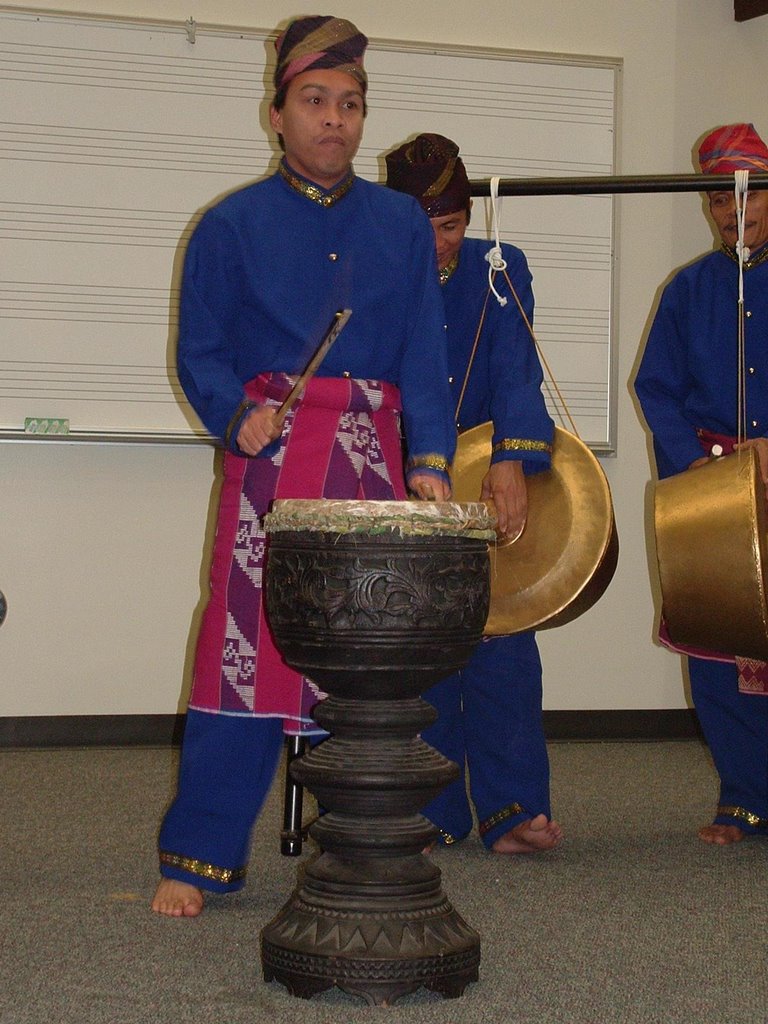CHORDOPHONES (STRINGED INSTRUMENTS)
Kudyapi - is a guitar with two strings. It is about 1 1/2 m long and made of wood. It has a stick to support in its lower end and is played in the same position as cello. It is common among Tirurays of Cotabato.
Karaga - is a guitar made up of bamboo where the strings are slit from the bamboo itself. The bamboo is split and tied back in both ends, leaving a slit as resonator. The guitar has strings all around it. This is popular in Eastern Mindanao.
AEROPHONES (WIND INSTRUMENTS)
Sahunay - is a bamboo flute, leaving six holes for the fingers and trumpet made of coconut leaf. It is about 50 cm long and 3 cm in diameter. This is a bamboo flute of the Tausugs in Sulu.
Kinapaw - is a nose flute of the Tinguians.
IDIOPHONES (PERCUSSION INSTRUMENTS)
Kulintang - is a set of eight knobbed gongs in graduated sizes from largest to smallest mounted in a wooden frame, about a meter long. Muslim carvings decorated the frame. The kulintang is played by striking the gongs with two pieces of wood, about 12 inches long while the player squats on the floor. The instruments is popular in Sulu.

Gabbang - is similar to a xylophone. It is made of wooden box with one end wider than the other, and with an open top. Across top, wooden bars of different lengths are placed to fit the shape of the box, about 1 cm from each other. It is played by striking the wooden bars with a wooden hammer. This instruments is popular in Sulu.
Bunkaka or Bilbil - is a bamboo musical instruments used by the Tinguians. It is a two-proged bamboo struck against the palm of one hand.

Agung - hangs from horizontal pole or wooden frame. The player stands besides the rim of the gong where he inserts his left arm through the ropes which suspend the instrument to position his hand comfortably at the knob. On the right hand, the player hold a mallet padded with rubber.
Gandingan - is a set of four graduated gongs, with thin rims and lower central knobs. They hang in pairs with the knobs of the lower pitched gongs facing each other. The same with the two higher pitched gongs. The pair of lower pitched gongs is positioned on the player's left side while the pair of the higher pitched gongs is on the right. The player usually a woman who stands between the two pair of gongs. Her body touches slightly the gong in the middle to prevent from swinging. She uses two padded mallets (one mallet for each air) to strike the gong's knobs.

Babendil - is small gong with thin rims and low central knobs. It is struck with thin bamboo sticks to produce a metallic sound.

There are three ways to play the babendil.
1. by striking the rim of the suspended gong with a pair of sticks on the left hand.
2. by striking the gong's rim with the right hand using one stick while the left hand grasps the rim.
3. by laying the instruments upside and striking the gong's rim with the two sticks.
MEMBRANOPHONES (DRUM INSTRUMENTS)
Dabakan - is a goblet -shaped drum, which has a single head covered with goat, lizard or snake skin. It is struck with two thin bamboo sticks about 18 inches in length.

Neguet - is a drum from Cotabato, 30 cm high, 20 cm in diameter
Sulibaw - is a drum 1/2 meter long and 15 cm in diameter
Tugo - is a tiruray drum 25 cm long, 20 cm in diameter.


